|
The acquisition is a leap forward for the Indian
Navy and the nation with the Indian Navy now joining
the exclusive club of five (USA, Russia, France,
UK and China) who operate nuclear submarines.
Traditionally, warships are rechristened with
the same name, so it is with the new Chakra, harking
back to the earlier INS Chakra (1988- 1991) which
blooded the Indian Navy to master the nuances
of nuclear propulsion with Russian help on board.
India’s submariners have lived up to the motto,
‘Run Deep and Run Silent’. By the very nature
of their sea going profession which is spent mostly
under water, and on long patrols especially in
nuclear submarines, submariners are reticent to
talk about their achievements and travails. This
is also a worldwide trait as a submariner is a
true professional and each man on the boat has
to ‘know his onions’ as it were and operate in
cramped conditions with no sunlight or fresh air
for weeks.
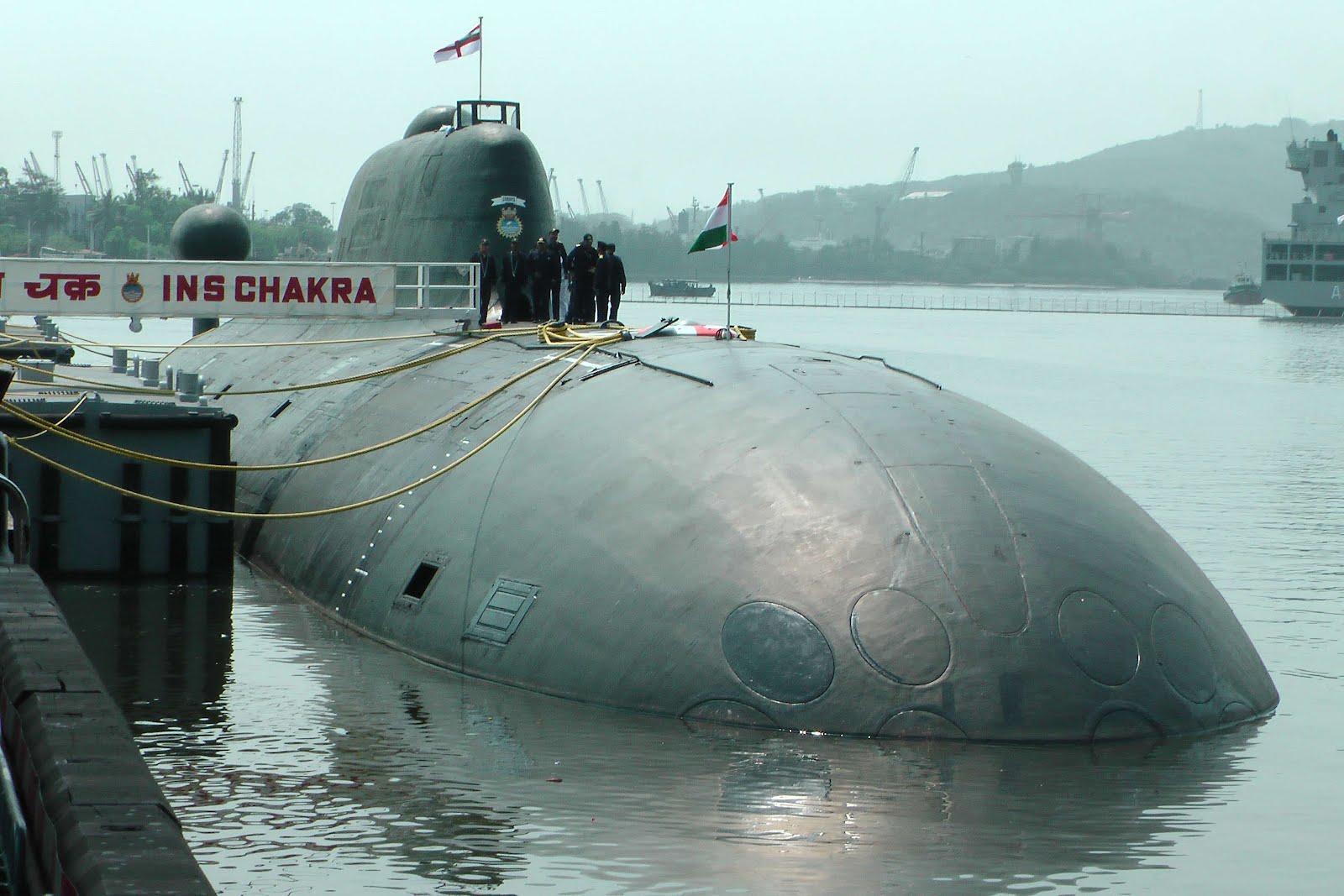 Defence
Minister A K Antony welcomed Captain P Ashokan,
a National Defence Academy (NDA) product and Naval
War College graduate who commanded two Kilo class
submarines, and his specially selected and highly
trained crew of INS Chakra at Vishakapatnam on
4th April, 2012 and formally inducted its addition
into the Indian Navy at the SBC in its new avatar. Defence
Minister A K Antony welcomed Captain P Ashokan,
a National Defence Academy (NDA) product and Naval
War College graduate who commanded two Kilo class
submarines, and his specially selected and highly
trained crew of INS Chakra at Vishakapatnam on
4th April, 2012 and formally inducted its addition
into the Indian Navy at the SBC in its new avatar.
The reconditioned Russian leased Chakra with
180MW nuclear power plant is the former 8,700
ton pear shaped Nerpa (Shark), a 971 ‘Shchuka
B’ Akula class nuclear submarine which was commissioned
on 23rd January, 2012 at Vladivostok by India’s
Ambassador in Moscow Ajai Malhotra.
The Indian crew under Capt Ashokan took over
from the Russian captain and crew which just as
Captain R N Ganesh in 1987 took over the earlier
Chakra from Captain Alexander Terenov, after completing
the extensive sea trials. Terenov and his wife
were invited to Vishakapatnam to witness the induction
of the new Chakra when submerged with ballast
water displaces 12,000 tons and has spacious and
comfortable living conditions.
The tanks are blown to pump out the water when
she surfaces and the INS Chakra can dive up to
500 meters, and would have completed deep diving
trials in Russia. The limiting depths are only
attempted in war or emergencies for the stress
the hull is put through.
Welcoming the boat on a bright and sunny morning
at Vishakapatnam’s SBC with many local VIPs and
officials of Andhra Pradesh including Ambassador
Alexander Kadakin of Russia and some Russian Navy
officers, Indian Navy Flag Officers, families
of the crew of INS Chakra and security cleared
media, both Defence Minister Antony and the Chief
of Naval Staff Admiral Nirmal Verma thanked the
Russian government for the excellent cooperation
for completing and refurbishing the Chakra, and
for the training that was provided by the Russian
naval team near St Petersburg and the shipyard
and base at Bay of Uliss near Vladivostok.
CNS Verma proudly disclosed the submarine had
completed the long 4,800 mile passage submerged.
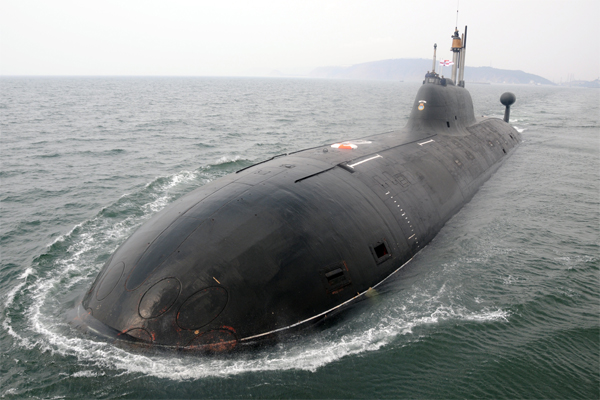
This is a very creditable achievement as the
submarine stealthily traversed the heavily traffic
laden Sea of Japan, the East and South China Sea
seas without surfacing, before entering the Bay
of Bengal under escort by INS Ranjit.
Ambassador Kadakin lauded the professionalism
of the crew of Chakra and recounted the strong
bonds of friendship between Russia and India over
the decades, which he said were so strong as to
provide nuclear submarines which no other nation
would.
The pear shaped hull submarines like the INS
Chakra propel faster under water than on surface
to take full advantage of their stealth features
and the calm of deeper waters, but it requires
very high precision navigation The depths can
be eerie for non-submariners.
Nonetheless, the creature comforts in modern
nuclear submarines are better laid out than in
conventional submarines and the larger nuclear
submarines can operate underwater endlessly.
It is the endurance of the crew that is the limiting
factor and US Navy has two sets of crew, Gold
and Blue, for each of its nuclear submarines.
Admiral Nirmal Verma and Flag Officer Commanding-in-Chief
Eastern Naval Command, Vice Admiral Anil Chopra,
apparently boarded the submarine off Vishakapatnam
as a the file photo shows with all its masts,
antennae and periscopes raised and the Indian
Naval ensign proudly fluttering in the breeze.
In 1988 late Prime Minister Rajiv Gandhi boarded
the earlier INS Chakra and welcomed her personally
in to Vishakhapatnam and a photo was flashed all
over the world. The Chakra’ s masts when raised
depict and include the Pelangator direction finder,
the satellite dish ‘Bark’, the ‘Radian and Bay’
and other radars, the EW antennae (Snoop etc)
and the Captain’s (Swan) and Officer of the Watch’s
(Signal 3) individual periscopes amongst other
receiver and transmitting paraphernalia on the
ships side.
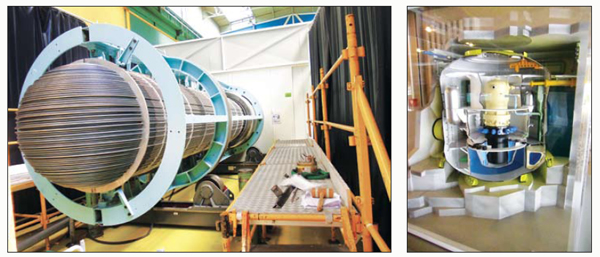
The aft section has a large pear elliptical
shaped black bulbous towed wire array (TWA) for
deploying the towed sonar and the floating communications
antennae, which is standard in submarines. The
Indian Navy has a very low frequency (VLF) communications
transmitting station on the eastern coast.
The RF station was set up with systems from the
Continental Electronics Corporation of USA and
is being upgraded by the same company under a
contract signed with Larsen and Toubro Ltd.
Admiral Verma recently laid the foundation stone
for the tall over 450 metre high transmitting
tower which will provide LF/VLF transmission to
IN submarines submerged and on patrol theoretically
up to over 2000 miles with slow bit rate transmission.
INS Chakra is nuclear propelled but not nuclear
armed. But with its Klub missiles and 533mm torpedoes
which can be launched under water, the boat will
equip the fast growing and powerful Indian Navy
to meet its many responsibilities in the Indian
Ocean.
The Chakra is an ultra quiet lethal underwater
powerful platform which enhances IN’s blue water
capabilities, with ability to remain underwater.
undetected for long patrols, and to tail and report
exercises in the region.
The INS Chakra is on lease for 10 years at a
cost of around $ 800 million, which lease actually
commenced on 11 June, 2011 at the Komsomolsk-on-Amur
shipyard with Indian witnesses, and were followed
up by extensive sea trials.
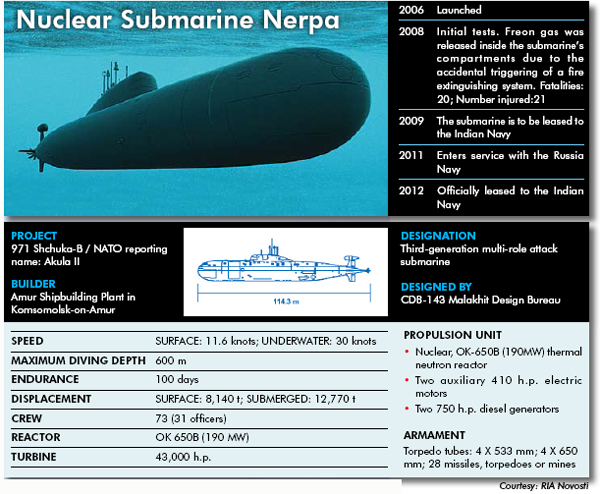
As the Nerpa of the Russian navy, it had suffered
an accident earlier during sea trials due to the
malfunctioning of a fire fighting device (reportedly
activated by a worker by mistake).
This delayed the commissioning by almost two
years.
The delay enabled the Indian crew however to
spend more time in submarine billets and become
a highly, twice trained team.
It is speculated that the nuclear tipped K-15
Sagarika vertical launch MRBM with a range of
around 700km, which is slated to arm the INS Arihant,
could be retrofitted in due course on INS Chakra
for angular underwater launch.
The canister based indigenous missile is being
tailored for the Army also as the Shaurya, emulating
what the US Navy did with sea and land based Harpoons.
Multiple successful launches of solid fuel K-15
missile from an underwater battery operated platform
replicating a submarine launcher have been reported
by DRDO. A plug of eight missiles on the INS Arihant
is planned for India’s true sea based deterrent
when the submarine is operational to make the
submarine a ballistic missile firing SSBN.
A LEAF DOWN THE PAST THAT
BECONS THE FUTURE
In the late 1980s, the Indian Navy boasted 21
submarines (14 now) in its Order of battle (ORBAT)
including a Project 670 Charlie class (K-43) nuclear-powered
cruise missile submarine INS Chakra.
The Indian Navy successfully operated and exploited
the full capabilities of the boat from 1988 to
1991 and gained confidence in operating and maintaining
the nuclear power plant and mastering the associated
stringent safety requirements under Russian supervision,
and set up a full fledged Nuclear Safety Directorate
at Naval Headquarters under a submariner Vice
Admiral, currently Vice Admiral S Chaterjee. This
directorate was made responsible to vet the safety
needs, and supervise the emergency drills and
checks, mandatory for all nuclear submarine operations.
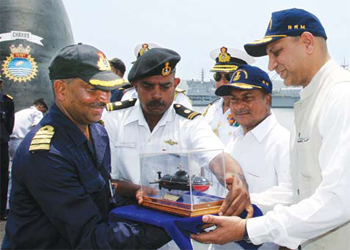 The
Navy returned the old Chakra in 1991 after the
submarine suffered a minor reactor emergency which
was well handled by its Indian crew and applauded
by the few Russian reactor crew men on board. The
Navy returned the old Chakra in 1991 after the
submarine suffered a minor reactor emergency which
was well handled by its Indian crew and applauded
by the few Russian reactor crew men on board.
The boat went on to join the Russian Pacific
Fleet after repairs. At about the same time in
1992, the steering committee under the Prime Minister
sanctioned funds for the construction of the Ship
Building Centre (SBC) at Vishakhapatnam for the
DRDO-led Project ATV (Advanced Technology Vehicle)
as a nuclear technology demonstrator submarine
under Aakanksha (meaning Hope) programme.
The over $ 2 billion project was kept under
wraps till the submarine was unveiled and named
INS Arihant on 26th July, 2009 by Mrs Gursharan
Kaur, wi fe of Pr ime Minister Dr Manmohan Singh.
No photography showing the shape or size of the
vessel was permitted.
A large tract of water and jetty space, and adjacent
land where the old INS Chakra was berthed and
operated from, was carved out from the sprawling
Naval Dockyard and turned in to a restricted area
for the construction of the highly classified
strategic project. This is also the home of the
new INS Chakra, till another forward operating
base is constructed South of Vishakhapatnam, also
known as Vizag.
The Vizag harbour has a very narrow entrance,
and the volume of merchant ship traffic is steadily
increasing. The narrowness is a debility which
Admiral of the Soviet Fleet Sergie Gorshkov had
pointed out in the 1970s during a visit here.
In fact, he offered to build a naval base at Bhimlipatnam
which has deep water.
But the then Prime Minister, Mrs Indira Gandhi,
wisely declined as the Soviet Union would have
asked for basing facilities. India did not want
to be drawn into the East-West Cold war.
Nonetheless, the need for a new naval base on
the East coast is vital and imperative.
The Chakra will be berthed and operated from
the SBC under the Flag Officer Submarines Rear
Admiral Srikant and Commodore Commanding Submarines
at INS Virbahu Commodore Sanjeev Raj Kapoor.
Vice Admiral DSP Verma, the Director General
ATV, was present during the induction and CNS
welcomed Vice Admiral RN Ganesh, and Rear Admirals
SC Anand and R K Sharma the three former Commanding
officers of the older INS Chakra.
There is complete secrecy on the mode and amounts
of payments for the Akula and the progress of
the attack guided missile attack submarine missile
equipped SSBN INS Arihant, but two more larger
nuclear powered submarines are reportedly on order
at SBC to be fitted with larger plugs for longer
range K-4 nuclear tipped missiles for nuclear
deterrence.
INS Chakra’s induction also contributes to fill
the void caused by the delay in the indigenous
INS Arihant and depleting strength of submarines.
The experience gained by the crew of Chakra from
the builders and support staff they interacted
with in Russia and on trials, will surely assist
the INS Arihant constructors and BARC engineers
at the SBC.
It is hoped the model set by INS Nilgiri, India’s
first Leander in the 1970s, and the first HDW
submarine built at at Mazagon Dock Ltd. (MDL)
will be emulated. In each case, their crew and
staff were trained abroad to help speed the projects.
After the acquisition of INS Chakra, it should
be so for INS Arihant also.
Mr Antony was asked if more submarines were on
offer and he replied that the Government was considering
a request for a second submarine from Russia.
No decision though yet had been taken.
India’s large two million sq km EEZ and vast
areas to patrol calls for many more submarines
as the current numbers are depleting and aging.
As a new era dawns for the Indian Navy, the Defence
Minister in his speech asked the Russian Ambassador
Kadakin to ensure that aircraft INS Vikramaditya
( aka Admiral Gorshkov) will be delivered on time,
as promised by 4 Dec 2012.
That acquisition with powerful MiG-29Ks flying
off its deck will be another game changer for
the Indian Navy to become a true blue water navy
as its personnel chant the Sanskrit words “Shan
No Varuna” (or May the Sea God Be Auspicious Unto
Us).
The Indian Navy is on a steady path of growth,
and much will depend on this guardian of our seas
and India’s maritime destiny in the 21st century.
Meanwhile, INS Chakra is ready to dive again within
weeks with some new crew members.
Admiral Verma invoked the blessing at the induction
and also wished the crew Fair Winds and Following
Seas for its coming assignments as part of the
naval traditions. Ahoy!
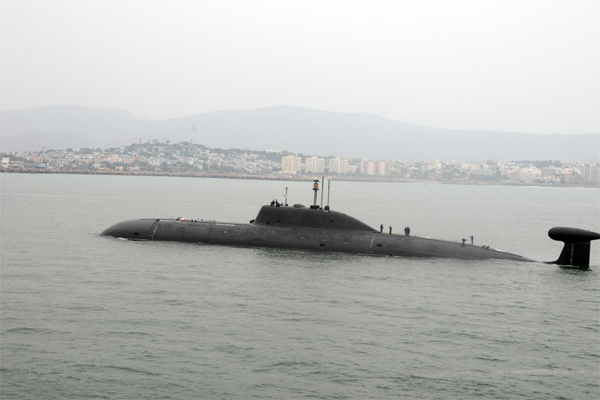
|